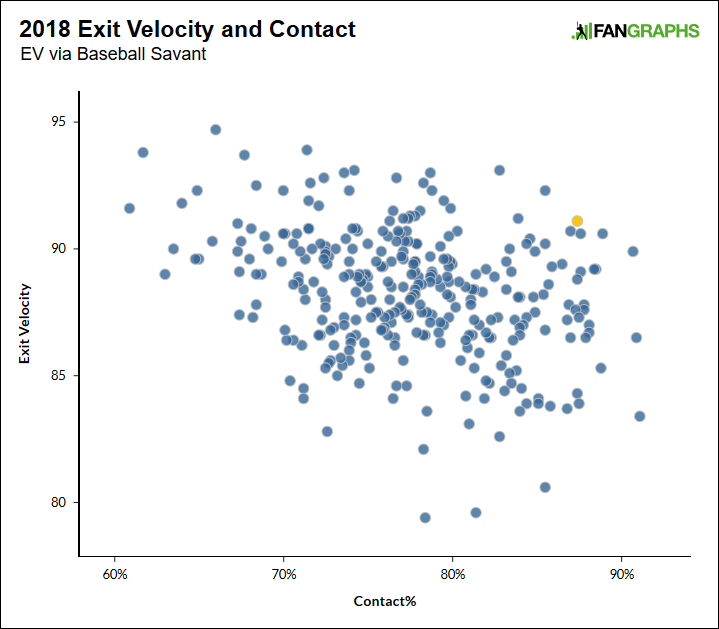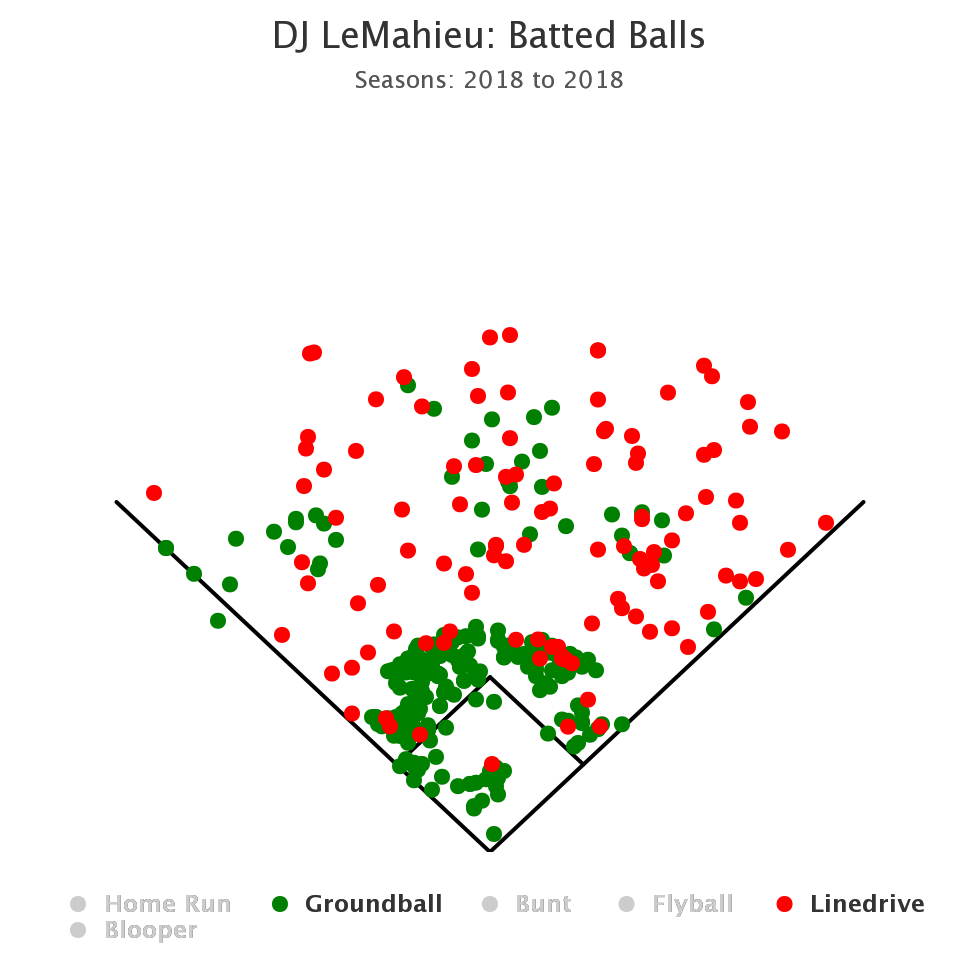In the abstract, the Mets’ signing of infielder Jed Lowrie to a two-year, $20 million contract is a nice little move. The team gets a versatile, well-regarded veteran who’s coming off such a strong enough year that he might have received double that guaranteed money in a more hospitable free agent market. In the real world, the signing of Lowrie raises more questions than it answers, questions for new general manager Brodie Van Wagenen about how the Mets plan to allocate playing time throughout not just their infield but their outfield, and about how they value the futures of the promising youngsters within both groups.
The switch-hitting Lowrie, who turns 35 in April, has spent the last three seasons with the A’s and is coming off career bests in home runs (23), wRC+ (122, with a .267/.353/.448 line), and WAR (4.9). That comes on the heels of a previous career high of 3.6 WAR in 2017, accompanied by 14 homers and a 119 wRC+. Before that, he had his ups and downs — we’ll get to those — and he has a long history of playing all over the infield, but during this two-year surge, 95% of his defensive innings have come at second base.
Of course, less than six weeks ago, the Mets traded for an eight-time All-Star second baseman in Robinson Cano, and just this past summer, in the second half of an otherwise lost season, they stumbled upon a productive, homegrown second baseman in Jeff McNeil. As with their outfield of the past two seasons — a collection light on capable center fielders, and populated with more lefty-swinging corner outfield bats than any reasonably assembled roster needs — it’s not at all clear how they intend to fit all of the parts together into a coherent whole. They do intend to play Lowrie every day, according to Newsday’s Steven Marcus, but with position(s) to be determined.
I’ll attempt to sort all of that out below, but first, Lowrie is worth a closer look. Before his big 2017 and ’18 seasons, you’d have to go back to 2013 to find a similarly strong campaign on his resumé. He was below replacement level in 2016 before missing the final two months of the season due to surgery to remove a bunion and repair a ligament in his left big toe, and from 2014-2016 hit for just an 89 wRC+ with 2.2 WAR in 292 games while missing additional time due to a fractured right index finger (2014) and a torn ligament in his right thumb (2015).
Lowrie, who lists at a modest 6-foot and 180 pounds, has cited improved lower body conditioning and late-2016 surgery to repair a deviated septum — a procedure that improved the quality of his sleep and his ability to recover from workouts — as reasons for his recent improvement. He speaks like a man aware of the flood of data available to players these days. “I look back at the success I’ve had in my career hitting, and the focus has always had to be on my legs, getting the most out of my legs as I can,” Lowrie told the San Francisco Chronicle’s Susan Slusser last April. “Some guys are strong enough to manipulate their mechanics and get an ideal launch angle. I’m trying to maximize bat speed to maximize exit velocity.”
As he told Sports Techie’s Joe Lemire in September:
“I check [Statcast] regularly. We have our system upstairs in the clubhouse, so if you see me leaving the dugout, 99 percent of the time it’s to go up and look at either video or exit velocity and launch angle. I use that information more as a debriefing. I can figure out that if I take the swing that I wanted to mechanically on a pitch that I know I can hit hard, but the exit velocity wasn’t what I expected it to be, then maybe it’s because my legs aren’t underneath me.”
By and large, Lowrie’s 2017 and ’18 Statcast numbers are better than his 2015 and-16 ones:
Jed Lowrie Via Statcast, 2015-2018
| Season |
GB/FB |
Exit Velocity |
Launch Angle |
wOBA |
xwOBA |
| 2015 |
0.80 |
89.0 |
16.2 |
.305 |
.310 |
| 2016 |
1.33 |
85.7 |
11.3 |
.282 |
.294 |
| 2017 |
0.68 |
88.8 |
18.6 |
.347 |
.375 |
| 2018 |
0.76 |
89.0 |
17.1 |
.348 |
.333 |
SOURCE: Baseball Savant
He’s elevating the ball more consistently and hitting it harder, which explains why he’s been more successful at ages 33 and 34 than earlier in his 11-year major league career, which began with the Red Sox (2008-2011) and has included multiple stays with both the Astros (2012, 2015) and A’s (2013-2014, 2016-2018). That should mitigate some fears about an expected fall-off in his mid-30s.
On the defensive side, Lowrie made 132 starts at second base in 2017, and 133 in 2018; he was above average there in the latter season (6.1 UZR, 1 DRS) after three straight years in the red by both metrics (-5.5 UZR, -12 DRS). He last played shortstop in 2016, and that was for just three innings, with 16 starts in 2015; his metrics had slipped far enough into the red prior that he’s best regarded as an emergency solution at the position these days. He’s played only a smidgen of third base recently (three innings in 2017, 14 starts in 2018); his most extensive work at the hot corner came in 2015, when he played 47 games and was within a run of average via both UZR and DRS.
In terms of his recent usage, Lowrie doesn’t look like the second coming of Ben Zobrist, Kiley McDaniel’s admiration notwithstanding, but the Mets, who lost out on the real Zobrist in December 2015, when he signed with the Cubs, are planning to move him around. Not only is second base overpopulated, but third baseman Todd Frazier is under contract for one more season and $9 million. Oh, and Lowrie, like Cano and Frazier, is a former Van Wagenen client. Things could get awkward as these guys fight for playing time, and in the meantime, it’s fair to raise an eyebrow regarding this agent-turned-GM’s penchant for collecting his aging former clients.
Indeed, right now, it’s hard to make sense of how Van Wagenen and manager Mickey Callaway plan to piece this together. Not only did they trade for Cano, they just added utilityman J.D. Davis for a rather steep prospect price. They got a nice 63-game rookie season out of McNeil and a not-so-nice sophomore campaign from shortstop Amed Rosario. They have last year’s first base prospect, Dominic Smith, and next year’s first base prospect, Peter Alonso. I don’t even dare crack wise about another reunion with Jose Reyes, as his 2018 season and the Mets’ justifications for keeping him were both terrible.
Let’s put these guys in a table:
Mets’ Infield Logjam
| Player |
Bats |
2019 Age |
Primary Pos |
Secondary Pos |
2018 WAR |
2019 Proj |
| Peter Alonso |
R |
24 |
1B |
— |
N/A |
1.5 |
| Dominic Smith |
L |
24 |
1B |
LF (LOL) |
-0.5 |
0.0 |
| Robinson Cano |
L |
36 |
2B |
1B |
2.9 |
3.3 |
| Jed Lowrie |
S |
35 |
2B |
3B, 1B? |
4.9 |
2.1 |
| Jeff McNeil |
L |
27 |
2B |
3B?, OF? |
2.7 |
1.1 |
| Amed Rosario |
R |
23 |
SS |
— |
1.5 |
2.1 |
| Todd Frazier |
R |
33 |
3B |
1B |
1.5 |
0.9 |
| J.D. Davis |
R |
26 |
3B |
1B |
-0.6 |
0.2 |
Alonso, Smith, and Davis all have minor league options; so does Rosario, but lacking a ready alternative at shortstop, we can ignore that. Worth adding to the picture is the knowledge that Smith’s stock is very low, that Davis is a bench piece for now, that McNeil didn’t seem to have any problems against southpaws as a rookie (124 wRC+, albeit in 62 PA), that Frazier suddenly struggled against lefties in 2018 (52 wRC+ in 129 PA), which may just be a fluke, and that Lowrie’s been about average versus lefties over the past two years while mashing righties. That still leaves a fierce game of musical chairs.
If the Mets go around the horn with Ye Oldest Lineup, Frazier-Rosario-Lowrie-Cano, then not only are they playing their marquee offseason acquisition at a position where he’s got just 14 games under his belt — and he’s still quite playable at second base (2.8 UZR in 2018) — but they need to figure out how to get enough playing time for McNeil, who hit .329/.381/.471 (137 wRC+); they clearly aren’t calling up Alonso (.285/.395/.579 with 36 homers split between Double-A and Triple-A) anytime soon in this scenario. If they go Lowrie-Rosario-McNeil-Cano, they’ve got two corner guys playing their lesser positions, a second baseman on whom the jury is still out defensively (0.4 UZR, -2 DRS), a bench player making $9 million, and again no clear path for Alonso. McNeil-Rosario-Lowrie-Cano trades a comparatively minor question about second base for a major one about whether McNeil can handle third, something the Mets appeared reluctant to find out in 2018. McNeil-Rosario-Cano-Lowrie? The new guy has a total of 28 major league innings at first base, all of them in Boston in 2010-2011; that’s 11 more innings than McNeil has played at first in the minors, lest you think about swapping those corners. Frazier-Rosario-Cano-Lowrie may as well be Lowrie-Rosario-Cano-Frazier; the Toddfather might be the better defender at both positions.
All of this is reminiscent of the Mets’ mismatched outfield of the past two seasons, with Jay Bruce, Curtis Granderson, Yoenis Cespedes, Michael Conforto, Brandon Nimmo, and no true center fielder besides the oft-injured Juan Lagares. Granderson was traded to the Dodgers in late 2017, Bruce went to Seattle in the Cano trade, Cespedes may not play at all in 2019 after surgery to remove bone spurs in both heels, Nimmo has established himself as one of their top hitters, and they just acquired Keon Broxton in a 3-for-1 deal, so it’s a stretch to say they’ve got things sorted out there beyond some kind of Conforto-Lagares/Broxton-Nimmo arrangement. Reportedly, they plan to find time for McNeil in the outfield, though he has just nine minor league appearances totaling 65.1 innings out in the pasture. At whose expense will that playing time come?
I don’t know those answers, and right now, I’m not sure the Mets do, either. The fear is that they’re now overly stocked with infielders in their mid-30s who are cutting into the playing time of infielders and outfielders in their 20s, but it’s worth acknowledging that Opening Day is 2 1/2 months away (gah) and that this move probably means others are in store. Perhaps they trade Frazier in a salary dump, or deal Conforto for another young, controllable player who fits their lineup better.
For all of the above hand-wringing, the good news is that Van Wagenen continues to add useful players, and that the Mets are projected to win 85 games, which should put them in the thick of the NL East fight. Van Wagenen’s vision of a competitive 2019 squad may not be my vision or your vision, but it’s certainly more visionary than what we’ve seen in Queens in the past couple of seasons, and that counts for something.



